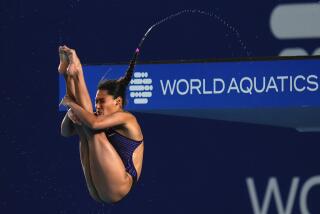Free-diving takes you to the depths of despair and the peaks of excitement
The final day of my Los Angeles free-diving course happened to coincide with my 12th wedding anniversary. Instead of drinking wine with my better half, I was scheduled to dive the Pacific Ocean to a depth of 75 feet — on a single lungful of air. It seemed an inconvenient, not to say selfish, day on which to drown.
I was new to free-diving. But I had read enough to know that the sport required strong nerves and large lungs.
Some professional divers reach depths of more than 400 feet without a breathing apparatus of any kind. Others die trying. On Nov. 17, 2013, Nick Mevoli blacked out after attempting a dive at a competition in the Bahamas. He never woke up.
As a tiny motorboat whizzed me to my Redondo Beach dive site that August afternoon, it seemed impossible to reach 75 feet and make it back to the surface alive.
Many free divers favor the warmer, clearer waters of Hawaii or the Yucatán Peninsula. Looking out at those choppy Californian waves, I was mindful of my marriage — not to mention my two kids.
Luckily for me, I was accompanied by one of L.A.’s finest instructors. Lance Lee Davis is a member of Performance Freediving International, or PFI, a free-diving training agency whose clients include Tom Cruise and David Blaine.
Lance recently represented Southern California in the CMAS (Confédération Mondiale des Activités Subaquatiques) Freediving World Championships, and performed sub-aquatic stunts for the soon-to-be-released sequel to “Avatar.”
“The water looks a little lumpy today,” he said, patting me on the back. “But it’s calm underneath.”
I gulped. The ocean depth was 500 feet.
I had jumped into the PFI intermediate free diver course with a blithe optimism. In hindsight, I should have taken the beginner’s class first. But it was too late. I had already signed up for four days’ training — two in the classroom and the pool, and two in the open sea.
My first classes took place at the back of Neptonics, a spearfishing store in Ventura. I was joined by two other students: Beck, a former circus stuntwoman from Pennsylvania, and Barton, a seasoned spear fisherman from Texas. I felt old and flabby compared with these two. But they were kind and encouraging. And for that, I was grateful.
During those first two mornings, we studied a host of breathing and relaxation techniques (more on those later). We also learned about the mammalian dive reflex, a physiological response to cold water and pressure that temporarily reduces the body’s consumption of oxygen. Pretty handy when you’re sinking into the abyss with no scuba gear.
We learned another important thing too: It seemed Lance was impervious to fear.
“I’ve arrived at dive sites in Northern California where there are half-eaten seals on the beach,” he said with a breezy smile. “But sharks don’t stop me diving if the underwater visibility’s good.”
“When the water’s murky and sharky — that’s my cut-off point,” he added.
Which only goes to show that one man’s cut-off point is another man’s run-for-the-hills-screaming-and-blubbering point. You can imagine where I fell in this equation.
After several hours of science and statistics, it was time to test my knowledge in the pool at nearby Ventura Dive & Sport. I pulled on my wet suit and outsize fins (akin to strapping helicopter blades to my feet) and jumped into the water next to Lance, Barton and Beck.
We began with a discipline known as static apnea, which means holding your breath underwater for as long as you can without blacking out.
The process began with long, steady breaths (diaphragmatic breathing), some gentle exhales (purge breathing) and one final, lung-expanding gasp. Floating face-down in the water I tried — and failed — to relax.
After about two minutes of oxygen starvation, I began to feel strong abdominal contractions — perhaps the closest I’ll ever come to experiencing childbirth. I stayed under for three minutes and 15 seconds, resurfacing with all the grace of an asthmatic walrus.
It was tricky. But it wasn’t all agony. The final intake of air was intoxicating, like draining a glass of Champagne in a single gulp.
I was secretly pleased with my result. That is until Brandon disgraced me with three minutes, 50 seconds, and Beck clobbered us both with four minutes, 45.
At the end of Day 2, I crawled into bed, utterly spent.
Day 3 arrived with a sense of foreboding. Today we were expected to practice our newly acquired skills in the ocean. I needed all the advice I could get, so I scheduled a call with Alexey Molchanov, known as the “deepest man on Earth.”
In July 2018, Molchanov dived to 426 feet, a world record. If anyone could offer me guidance, surely it was he.
“Free-diving highlights your fears,” he told me from his hotel room in Bali. “But it can also help you overcome them.
“To conserve oxygen, you want to be careful about your thought processes. And you need to make sure you don’t get freaked out.”
Even over the phone, it was evident that Molchanov was a man of superhuman cool. I liked him a lot, not least because he had managed to distill the wisdom of free-diving into four easily memorable words: DON’T. GET. FREAKED. OUT.
I took this message to heart. Throughout my first day in the ocean, I regularly forced myself to slow down, calm down and carry on.
It wasn’t easy. But by the middle of the afternoon, I had pulled myself down an anchored line to 60 feet, a process known as free immersion. More important, I had made it back to the surface without coughing up blood or losing a limb to a razor-fanged fish. I felt like Jacques Mayol, the hero of Luc Besson’s classic free-diving movie, “The Big Blue.”
But I didn’t dare relax. I still had the final day’s training to contend with. To pass my test, I needed to let go of the anchored line and swim beyond the 60-foot mark to negative buoyancy, the point at which the body begins to sink toward the ocean floor. I wasn’t looking forward to dropping into the icy void. It seemed counter-intuitive — one might even say bloody-minded.
On that fourth and final afternoon, I made several abortive attempts at my 75-foot target, one of which had me racing to the surface in thinly disguised panic.
“Are his lips blue?” Barton asked as I reemerged, spluttering.
“Bluish,” Lance said. “No biggy.”
After several hours of fumbled failures, I finally made it to the 75-foot plate. Pausing for a moment in the inky silence, I tried to ignore the pressing urge to breathe and focus instead on Molchanov’s “don’t get freaked out” mantra.
I fixed my eyes on the line, kicked hard with my giant fins and quickly arrived at a depth of 30 feet. The water was lighter and warmer here, and gravity was drawing me deliciously skyward.
At 10 feet, I could see clouds distorted through the silvery waves. I finally broke the surface, holding my arms high above my head and releasing the precious air in a joyful eruption of bubbles. Beck was screaming at me to breathe. It was a beautiful feeling simply to obey.
“Fifty seconds,” said Lance, glancing at his watch. “That’s textbook, man. Well done.”
My first taste of free-diving was thrilling and chilling in equal measure. But I’m determined to try it again. Next time, perhaps I’ll sample the flatter, warmer waters of Hawaii — and try to avoid important birthdays and anniversaries.
I was euphoric after my Redondo Beach dive. But I was also desperate to go home. After four long days, it was time to put some space between me and death, to buy a good bottle of wine, and to celebrate 12, more or less blissful, years of marriage.
WHERE TO LEARN
Lance Lee Davis teaches Los Angeles classes year-round. The classroom sessions take place at Neptonics Ventura; the pool sessions at Ventura Dive & Sport; and the open-water sessions at Redondo Beach.
PFI Intermediate Freediver is a four-day course including classroom, pool and open-water training. Students can dive to a maximum of 433 feet. Prices start at $745 per person.
PFI Beginners Freediver is a two-day introductory course. Students can dive to a maximum of 66 feet. Prices start at $395 per person.
WHERE TO DIVE
Here are some of Lance Lee Davis’ favorite free-diving locations:
Mexico: The cenotes (natural, spring-fed sinkholes) around Tulum offer some of the best diving on the planet, with as much as 200 feet of underwater visibility.
Bahamas: Dive in warm, crystalline water through acres of shallow coral heads. The local pantropical spotted dolphins are friendly and playful.
Hawaii: The Kona coast enjoys pristine conditions year round. There’s a large free-diving community here, so it’s easy to find safety buddies.
Honduras: Roatán Island is a popular spot for amateurs and professionals alike. The CMAS Freediving World Championships will be held there on Aug. 6-11.
More to Read
Sign up for The Wild
We’ll help you find the best places to hike, bike and run, as well as the perfect silent spots for meditation and yoga.
You may occasionally receive promotional content from the Los Angeles Times.






